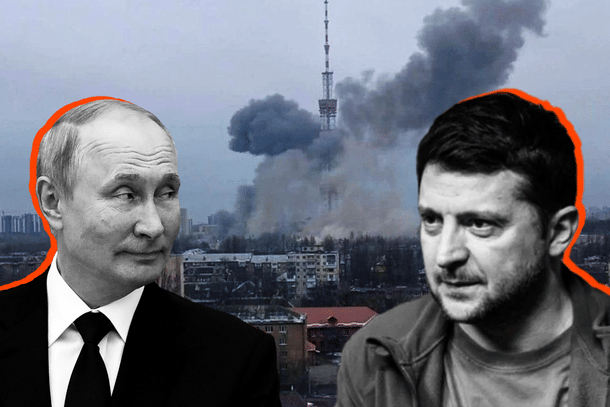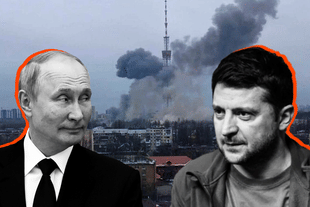World
Ukraine Lowers Age For Conscription From 27 To 25 — Will It Change Its Fortunes On The Battlefield?
Ujjwal Shrotryia
Apr 07, 2024, 12:48 PM | Updated 01:15 PM IST
Save & read from anywhere!
Bookmark stories for easy access on any device or the Swarajya app.


Will the reduction in the age of conscription from 27 to 25 change the fortunes of the Ukrainian military on the battlefield?
Ukrainian President Volodymyr Zelensky signed a law this week that lowered the minimum age at which young men can be drafted into the military from 27 to 25.
Fighting-age men, from 18 to 60, already cannot leave the country, aside from some exceptions. However, only men aged 27 or above can be drafted into the military. This law brings that age down to 25 years.
This reduction in the age of conscription has been a long-standing demand of the Ukrainian military, with the draft of the law pending in the parliament since 2023.
When the war started in February 2022, there were a lot of Ukrainians willing to join the fight against Russia. However, as the war progressed and casualties mounted, Ukraine went through multiple rounds of mobilisation.
Now, two years later, the long queues of volunteers at recruitment centres willing to serve in the army have dried up.
With hopes of winning the war quickly fading and the likelihood of draftees not returning home rising, Ukrainians have started to avoid joining the military.
Fighting-age men are using every means possible to avoid getting drafted into the military — from using fake health certificates to fleeing the country with falsified documents to hiding in their homes.
Police and the military are often seen walking the streets and handing out draft notices, checking fighting-age men at checkpoints.
This reduction in age is, therefore, a highly unpopular move among the masses, and that is why the draft of the law was stuck in the Ukrainian Parliament (Rada) for so long.
The Ukrainian military hopes that this move can bring an additional 400,000 to 500,000 soldiers into its ranks to fill the depleted ranks in the last two years.
The military hopes that these recruits will go some way to addressing the shortages in numbers.
Notably, many of the Ukrainian brigades are operating with just 75 per cent of the approved strength of 3,000 to 5,000. The situation is so bad that some brigades have to make do with just 25 per cent of their mandated strength.
The Russians, on the other hand, with three times more population, can sometimes muster a majority of 5-to-1 in certain sectors.
This move, however, is not going to change the results on the frontlines, at least in the short to medium term.
One, Ukraine cannot spare experienced men to train the new recruits, as they are already short on numbers.
Two, Ukraine does not have any training facilities, so most of the recruits have to be sent to foreign countries. Even if Ukraine had such a training facility, it would become a juicy target for Russian missiles.
Third, making a soldier out of new recruits takes time. Recruits won’t become hardened soldiers capable of withstanding the assault of experienced Russians when a large barrage of Russian artillery and aerial bombs are falling in their vicinity, in just five to six weeks of training.
The new recruits won’t be a significant factor, at least, in the next five to six months, by which time the Russians are planning their next counter-offensive.
The Ukrainian Government, to assuage these concerns, says that the new recruits will not be sent to the frontlines immediately. Instead, the ones that are in the rear will be sent forward with the new recruits taking their place.
Fourth, and most importantly, just throwing manpower at the enemy does not win wars.
Firepower is equally important, something which the Ukrainians are lacking, and that too, massively. The Russians have an advantage of 5-to-1, or sometimes even more, in terms of artillery shells that can be thrown downrange.
The United States was the biggest supplier of artillery ammunition to Ukraine. With the dwindling stocks of artillery ammunition in the inventory of Ukraine’s European NATO allies and the support package in the US Congress stuck, the Ukrainian Military is seriously short on artillery ammunition supplies.
If these shortages remain at the time of the impending summer Russian attack projected to be launched sometime in June, it is very hard to imagine how Ukraine will be able to hold the line.
The Czech Republic is spearheading an initiative to find as much artillery ammunition as they can. Other European countries are also chipping in the initiative, but how fast they can supply these to Ukraine in time for the Russian attack to materialise, remains to be seen.
Fifth, all the above does not even count the newer tactics employed by the Russians, i.e., the use of long-range glide bombs which Ukraine practically does not have any answer for.
Their aviation is seeing a resurgence with the use of new tactics. The recent Russian victory at Avdiivka is attributed in large part to the increased use of long-range gliding kits that convert dumb bombs to long-range precision munitions, out of the targeting range of Ukrainian air defence.
Seeing that all the odds are stacked against the Ukrainians, it is hard to imagine whether lowering the age of conscription will have a positive impact on Ukraine on the frontlines.
Staff Writer at Swarajya. Writes on Indian Military and Defence.





